Mechanism and Prevention of Main Roadway Roof Shock in Strong-Bump Coal Seam with Asymmetric Goaf
Abstract
:1. Introduction
2. Overview of the Case Study Mining Site
2.1. Basic Situation of Main Roadway
2.2. Micseismic Activity and Surface Subsidence
3. Mechanical Analysis of Roadway Roof Shock Damage
4. Mechanism of Shock Failure of the Main Roadway Roof in the Coal Seam with Asymmetric Goaf
4.1. Stress Distribution Characteristics of Main Roadway
4.2. Structural Evolution Characteristics of Overlying Strata in Main Roadway
4.3. Shock Failure Mechanism of Main Roadway Roof
- (1)
- Analysis of static load on the main roadway. Numerical simulation results indicate that, apart from the foundational static load provided by the original rock stress σv, the main static load increments in the main roadway’s surrounding rock come from the stress increments ∆σs1 and ∆σs2 caused by abutment pressure in the goaf on both sides of the roadway. In addition, the excavation of adjacent main roadways leads to changes in the stress distribution of the main roadway’s surrounding rock, resulting in a change for a single main roadway, denoted as ∆σs3.
- (2)
- Analysis of dynamic load on the main roadway. The seismic activity patterns on both sides of the main roadway and the characteristics of overlying rock structure changes indicate that the primary source of dynamic load on the main roadway comes from disturbances caused by the excavation of working faces on both sides, disturbances from adjacent main roadway excavation, and dynamic loads generated by damage in the overlying strata, denoted as ∆σd1, ∆σd2, and ∆σd3.
- (3)
- Analysis of “mutual feedback” effects in the goafs on both sides of the main roadway. As the goaf area increases on the west side of the main roadway, the height of fractures in the overlying strata and the overall strata activity increase. The static load generated by the cantilever on the goaf side and the dynamic load generated by rock fractures both increase. With the increased load, the corresponding influence distance also increases. When the influence range extends to the active range of strata in the goaf on the east side of the main roadway, there is mutual interaction between the strata structures on both sides of the roadway, resulting in respective static and dynamic loads denoted as and .
5. Method and Effect Analysis of Rock Burst Prevention and Control
5.1. Prevention and Control Method
5.1.1. Location Optimization of Main Tailgate
5.1.2. Roof Breaking by Deep-Hole Blasting
5.2. Prevention and Control Effect Inspection
6. Conclusions
- (1)
- The results of mechanical analysis suggest that the factors influencing the roof shock failure of the main roadway primarily fall into two categories: the strength of the strata-support structure and the horizontal stress in the surrounding rock. For the already-formed main roadway under the influence of an asymmetric goaf, the key to roof shock failure lies in the magnitude of the goaf abutment pressure and the strength of the roof strata activity.
- (2)
- Numerical simulation results demonstrate that with the sequential mining of the district faces, the distribution of roof stress in the main roadway gradually changes from the main headgate > auxiliary main headgate > main tailgate to the main tailgate > main headgate > auxiliary main headgate. Additionally, as the area of the goaf on the west side gradually increases towards the south, the peak stress on the main roadway roof continues to increase, and the stress increment shows a trend of increasing first and then decreasing.
- (3)
- Based on surface subsidence data and analysis of mining-induced subsidence theory, the structural evolution of the roof strata in the main roadway changes from an “asymmetric T” shape to a gradually “symmetric T” shape in the transverse profile. With the evolution of the roof strata structure, the mutual feedback effect of strata activity on both sides of the roadway gradually strengthens.
- (4)
- The distribution of roof stress and strata structure in the coal seam main roadway of the fourth district is influenced by the asymmetric goaf, experiencing three different stages: one side of subcritical mining influence → both sides of subcritical mining influence → one side of subcritical mining and one side of critical mining influence. Considering the impact of various factors in different stages, the theoretical criteria for roof shock failure in the main roadway are determined.
- (5)
- Based on the coal seam main roadway roof shock mechanism with the asymmetric goaf, a load reduction and impact reduction plan mainly composed of roof blasting has been developed. The on-site practice has shown good results, providing guidance and reference for the prevention and control of rock burst under similar conditions.
Author Contributions
Funding
Institutional Review Board Statement
Informed Consent Statement
Data Availability Statement
Conflicts of Interest
References
- Pan, Y.S.; Song, Y.M.; Liu, J. Pattern, change and new situation of coal mine rockburst prevention and control in China. Chin. J. Rock Mech. Eng. 2023, 42, 2081–2095. [Google Scholar]
- Cao, A.Y.; Dou, L.M.; Bai, X.Q.; Liu, Y.Q.; Yang, K.; Li, J.Z.; Wang, C.B. State-of-the-art occurrence mechanism and hazard control of mining tremors and their challenges in Chinese coal mines. J. China Coal Soc. 2023, 48, 1894–1918. [Google Scholar]
- Pan, J.F.; Liu, S.H.; Xia, Y.X.; Gao, J.M. Impact failure characteristics and support methods of roadway in largely-inclined broken coal seams. J. Min. Saf. Eng. 2021, 38, 946–953. [Google Scholar]
- Feng, L.F.; Dou, L.M.; Wang, H.; Wang, X.D.; Xu, G.G.; Zhang, Q.; Jiao, B. Mechanism of rockburst in dense roadway area near the goaf of fully-mechanized large pillars. Min. Saf. Eng. 2021, 38, 1100–1110+1121. [Google Scholar]
- Dou, L.M.; Tian, X.Y.; Cao, A.Y.; Gong, S.Y.; He, H.; He, J.; Cai, W.; Li, X.W. Present situation and problems of coal mine rock burst prevention and control in China. J. China Coal Soc. 2022, 47, 152–171. [Google Scholar]
- Wu, S.K.; Zhang, J.W.; Song, Z.X.; Fan, W.B.; Zhang, Y.; Dong, X.K.; Zhang, Y.J.; Kan, B.H.; Cheng, Z.S.; Zhang, J.T.; et al. Review of the development status of rock burst disaster prevention system in China. J. Cent. South Univ. 2023, 30, 3763–3789. [Google Scholar] [CrossRef]
- Pan, J.F.; Liu, S.H.; Gao, J.M.; Song, X.K.; Xia, Y.X.; Wang, Q. Prevention theory and technology of rock burst with distinguish dynamic and static load sources in deep mine roadway. J. China Coal Soc. 2020, 45, 1607–1613. [Google Scholar]
- Mazaira, A.; Konicek, P. Intense rockburst impacts in deep underground construction and their prevention. Can. Geotech. J. 2015, 52, 1426–1439. [Google Scholar] [CrossRef]
- Askaripour, M.; Saeidi, A.; Rouleau, A.; Mercier-Langevin, P. Rockburst in underground excavations: A review of mechanism, classification, and prediction methods. Undergr. Space 2022, 7, 577–607. [Google Scholar] [CrossRef]
- Skrzypkowski, K.; Zagórski, K.; Zagórska, A.; Apel, D.B.; Wang, J.; Xu, H.; Guo, L. Choice of the Arch Yielding Support for the Preparatory Roadway Located near the Fault. Energies 2022, 15, 3774. [Google Scholar] [CrossRef]
- Farhadian, H. A new empirical chart for rockburst analysis in tunnelling: Tunnel rockburst classification (TRC). Int. J. Min. Sci. Technol. 2021, 31, 603–610. [Google Scholar] [CrossRef]
- Pan, J.F.; Yan, Y.D.; Ma, X.H.; Xie, F.; Ma, W.T.; Lv, D.Z.; Song, X.D.; Feng, M.H. Mechanism and prevention pf rock burst in coal seam roadway group considering time-varying characteristics. J. China Coal Soc. 2022, 47, 3384–3395. [Google Scholar]
- Wang, G.A.; Zhu, S.T.; Jiang, F.X.; Li, S.D.; Liu, J.H.; Zhou, T.; Ning, Y.Z.; Li, H.; Kong, Z. Creep instability rock burst mechanism and prevention technology of isolated coal mass in roadways of high-stress thick coal seam. Chin. J. Geotech. Eng. 2022, 44, 1689–1698+9. [Google Scholar]
- Gao, M.S.; Xu, D.; Wang, H.C.; Yu, X.; Liu, R.F. Shock failure mechanism of roadway in extra thick coal seam and full anchor cable support technology. J. China Coal Soc. 2023, 48, 1943–1956. [Google Scholar]
- Xia, Y.X.; Pan, J.F.; Xie, F.; Feng, M.H.; Liu, S.H.; Liu, C. Disaster mechanism and control technology of large roadway group with repeated impact in extra-thick coal seam. Chin. J. Rock Mech. Eng. 2022, 41, 2199–2209. [Google Scholar]
- Liu, S.H.; Pan, J.F.; Xi, G.J.; Jiao, B.; Xia, Y.X.; Shi, X.X. Study on the mechanism and prevention and control of roadway impact in strong impact coal seam under the influence of mining. J. China Coal Soc. 2023, 1–9. [Google Scholar]
- Zheng, J.W.; Ju, W.J.; Lv, D.Z.; Sun, X.D.; Jiang, P.F.; Li, H.T.; Fu, Y.K.; Du, T.T.; Liu, B. Mechanism and practice of roof strip weakening method for preventing rockburst in central roadway. J. China Coal Soc. 2023, 48, 1169–1178. [Google Scholar]
- Smoliński, A.; Malashkevych, D.; Petlovanyi, M.; Rysbekov, K.; Lozynskyi, V.; Sai, K. Research into Impact of Leaving Waste Rocks in the Mined-Out Space on the Geomechanical State of the Rock Mass Surrounding the Longwall Face. Energies 2022, 15, 9522. [Google Scholar] [CrossRef]
- Seryakov, V.M.; Krasnovsky, A.A. Stress State of Support System in Temporary Roadway in Unstable Rock Mass. J. Min. Sci. 2022, 58, 911–919. [Google Scholar] [CrossRef]
- Cui, F.; Jia, C.; Lai, X.P.; Cheng, J.Q. Study on the evolution characteristics and stability of overburden structure in upward mining of short distance coal seams with strong burst tendency. Chin. J. Rock Mech. Eng. 2020, 39, 507–521. [Google Scholar]
- Ding, Z.W.; Li, X.F.; Zhang, J.; Zhao, Z.Q.; Xue, B.; Di, G.Q.; Shen, S.K. A theoretical analysis of unsupported roof plate and shell in excavation roadway and numerical calculation and verification of transcendental function. J. Min. Saf. Eng. 2021, 38, 507–517. [Google Scholar]
- Li, Y.P.; Zhao, S.K.; Li, Y.; Wang, Y.; Qing, K.; Sun, D.Q.; Li, Y.Z.; Zhao, Y. Prediction on weighting classification of fully-mechanized caving mining under extremely thick coal seam. J. China Coal Soc. 2021, 46, 38–48. [Google Scholar]
- Liu, H.; Li, Y.; Su, L.J.; Zhu, X.J.; Zhang, P.F.; Yao, M.M.; Wang, J.Z.; Wang, Q.W.; Si, G.Y. Surface deformation law of mining under thick loose layer and thin bedrock: Taking the southern Shandong Mining Area as an example. Coal Sci. Technol. 2023, 51, 11–23. [Google Scholar]
- Ren, X.Y.; Hao, B.Y.; He, F.S.; Wang, H.W.; Miao, Q.W. Research on staggered distance of upper and lower coal seam cooperative mining face based on subsidence prediction. Coal Sci. Technol. 2022, 50, 102–108. [Google Scholar]
- Peng, S.L.; Cheng, H.; Yao, Z.S.; Rong, C.X.; Cai, H.B.; Zhang, L.L. Study on prediction and characteristics of surface subsidence in mining when the bottom aquifer of thick loose layer directly covers thin bedrock. J. China Coal Soc. 2022, 47, 4417–4430. [Google Scholar]
- Xue, C.C.; Cao, A.Y.; Niu, F.W.; Wang, X.Y.; Shen, Z.P.; Tang, K. Mechanism and prevention of rock burst in deep irregular isolated coal pillar. Min. Saf. Eng. 2021, 38, 479–486. [Google Scholar]
- Guo, W.H.; Cao, A.Y.; Wen, Y.Y.; Xue, C.C.; Lv, G.W.; Zhao, Q. Mechanism of rockburst in stopes with typical thick roof and wide coal pillars in Ordos mining area. Min. Saf. Eng. 2021, 38, 720–729. [Google Scholar]
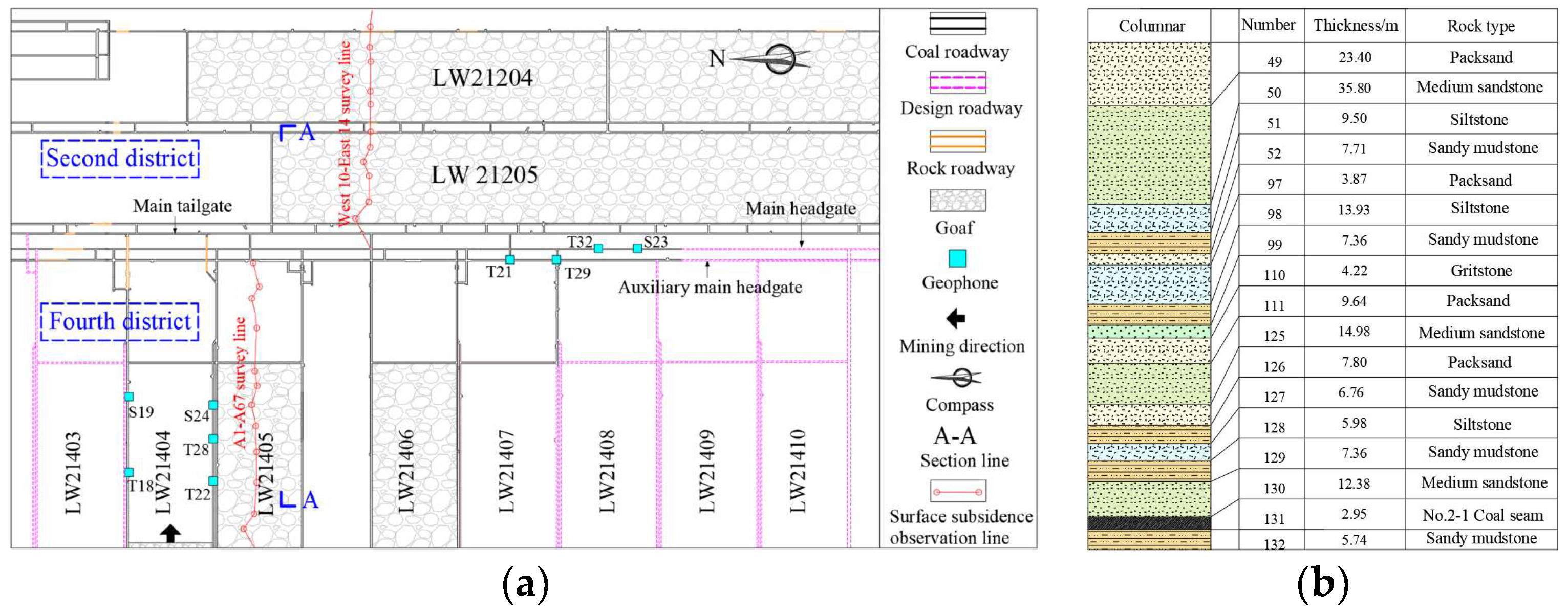

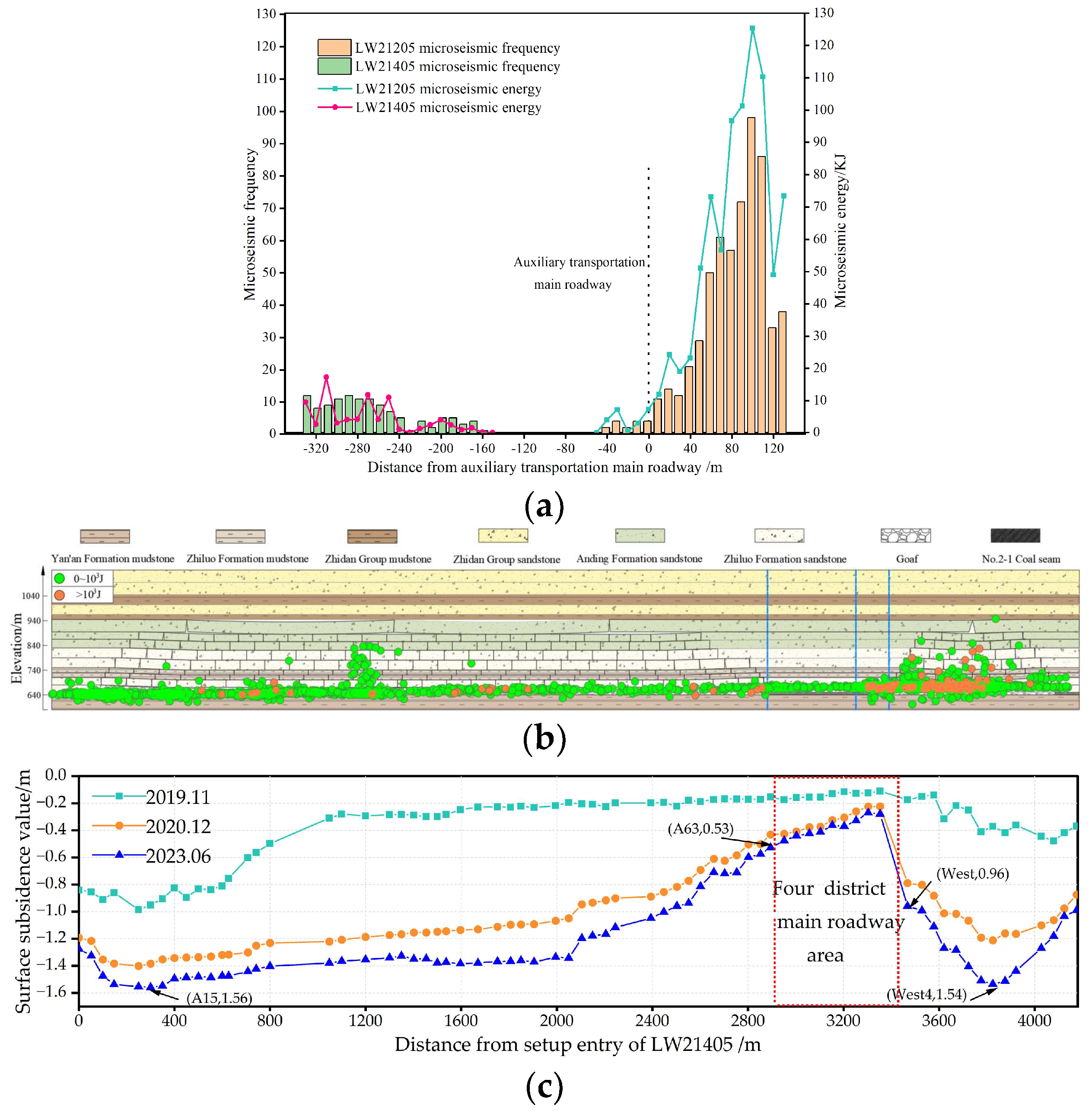
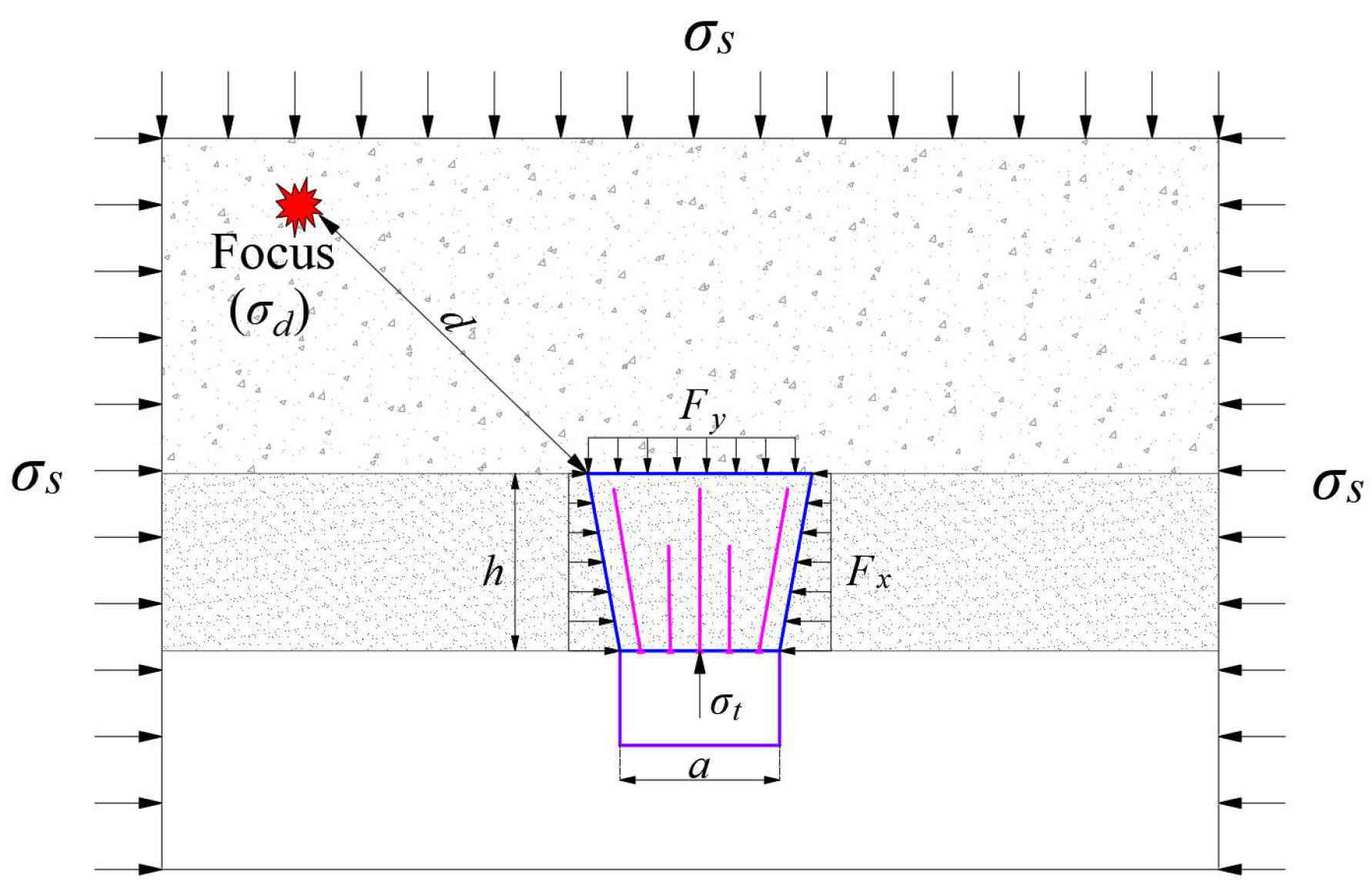

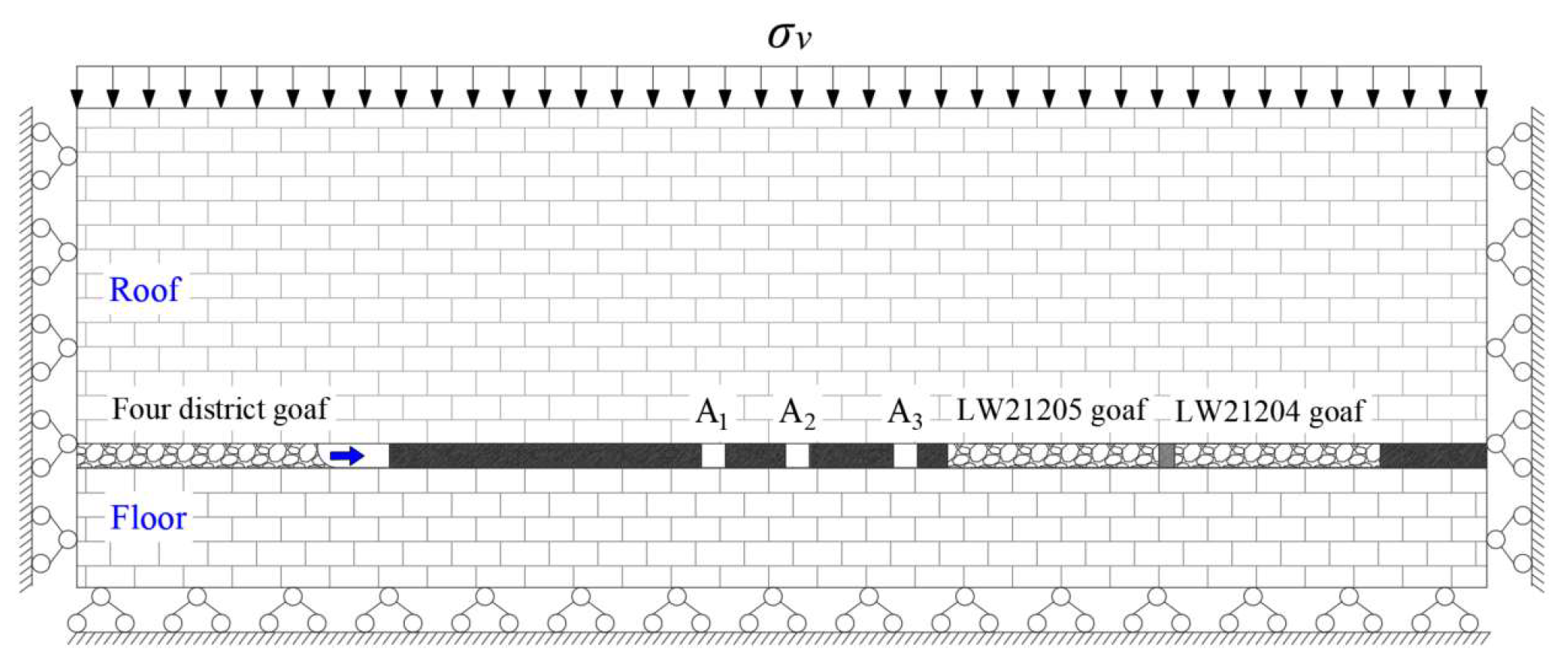
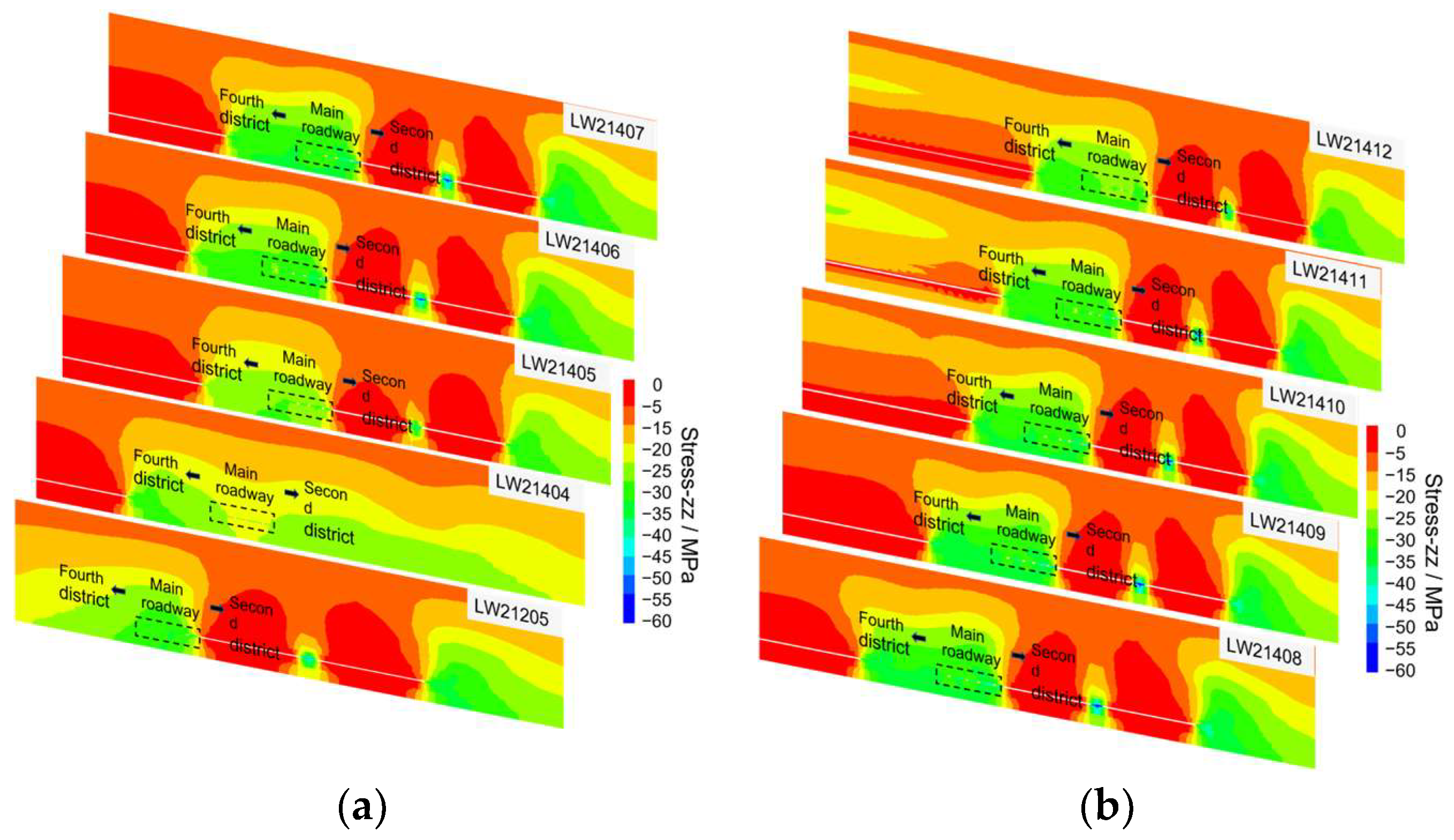

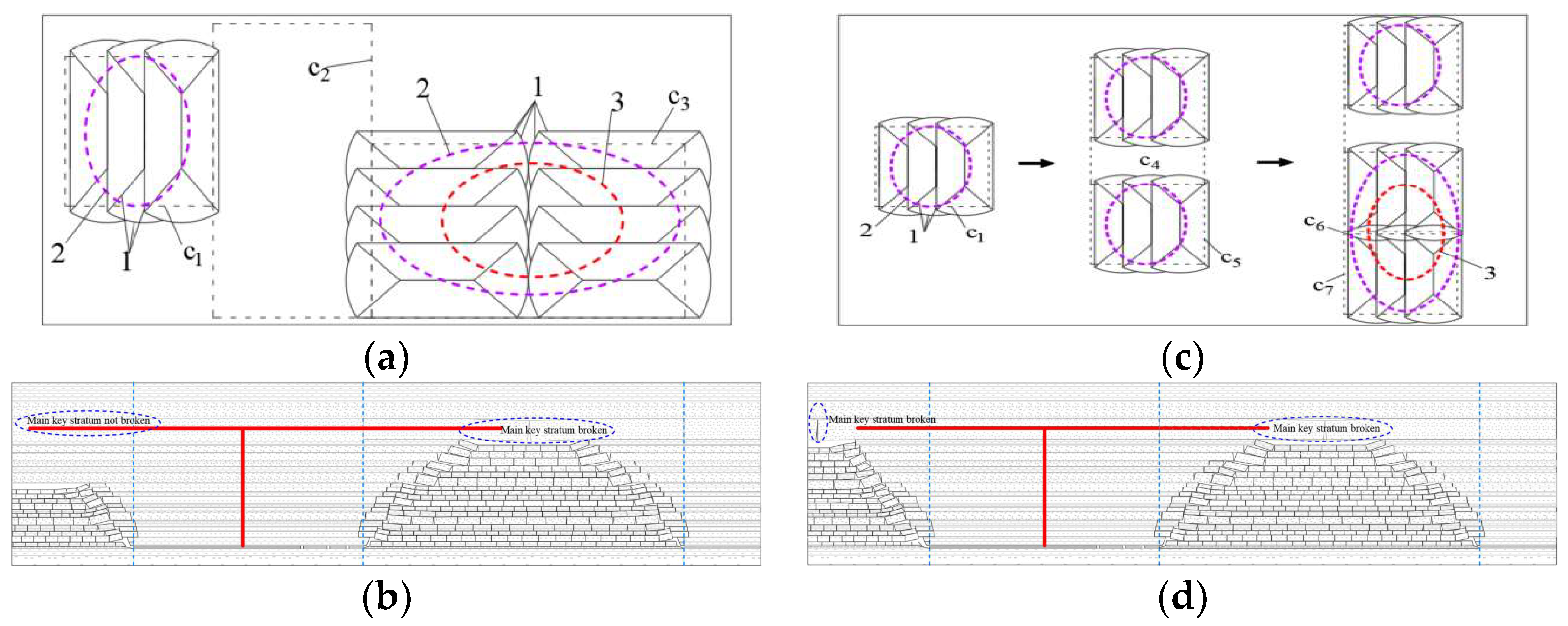

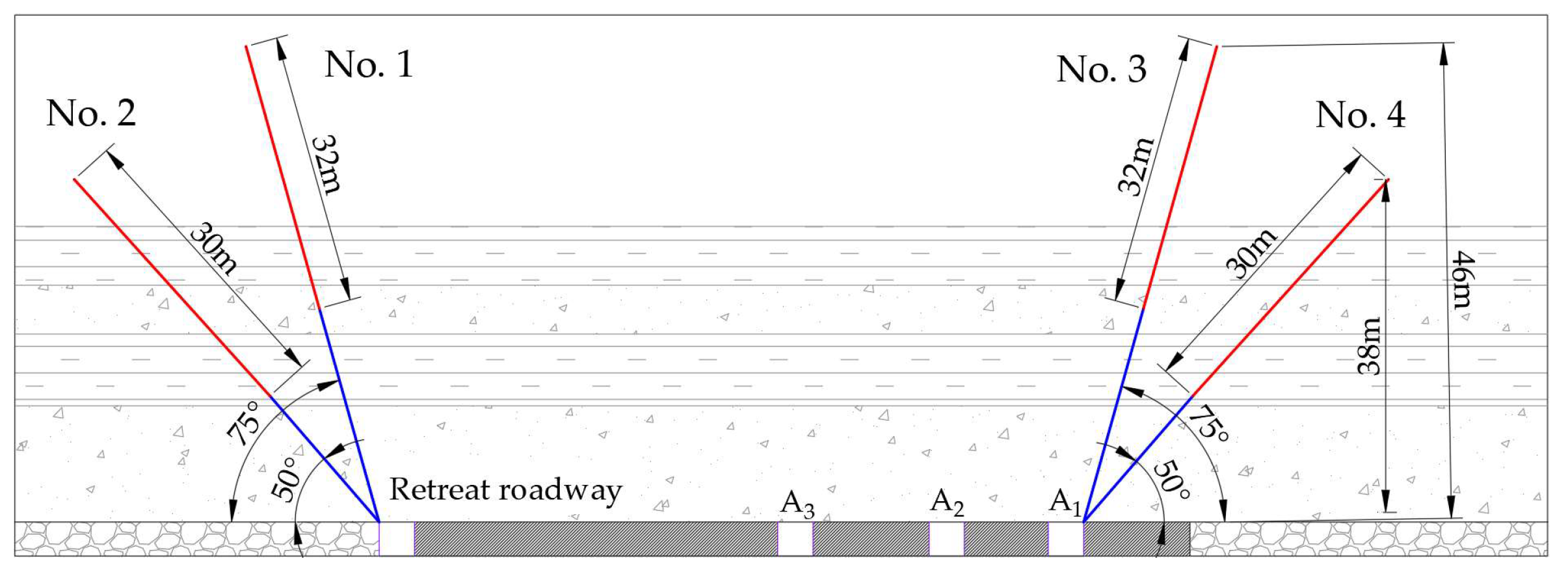

| Lithology | Density (kg/m3) | Bulk (GPa) | Shear (GPa) | Cohesion (MPa) | Friction (°) |
|---|---|---|---|---|---|
| Coal | 1540 | 4.12 | 1.47 | 8.60 | 36 |
| Packsand | 2250 | 1.44 | 3.35 | 13.0 | 35 |
| Sandy mudstone | 2450 | 1.55 | 3.82 | 8.0 | 36 |
| Medium sandstone | 2700 | 2.50 | 1.80 | 1.70 | 38 |
| Strata Type | Thickness (m) | Vertical Distance to Coal Seam (m) | Key Strata Class |
|---|---|---|---|
| medium sandstone | 12.38 | 0.00 | subkey strata one |
| Sandstone group | 22.78 | 32.28 | subkey strata two |
| Sandstone group | 17.80 | 129.30 | subkey strata three |
| medium sandstone | 35.80 | 305.62 | main key strata |
| Number | Aperture (mm) | Depth (m) | Charge Length (m) | Explosive Charge (kg) | Dip Angle (°) |
|---|---|---|---|---|---|
| 1 | 75 | 60 | 32 | 96 | 75 |
| 2 | 75 | 50 | 30 | 90 | 50 |
| 3 | 75 | 60 | 32 | 96 | 75 |
| 4 | 75 | 50 | 30 | 90 | 50 |
Disclaimer/Publisher’s Note: The statements, opinions and data contained in all publications are solely those of the individual author(s) and contributor(s) and not of MDPI and/or the editor(s). MDPI and/or the editor(s) disclaim responsibility for any injury to people or property resulting from any ideas, methods, instructions or products referred to in the content. |
© 2024 by the authors. Licensee MDPI, Basel, Switzerland. This article is an open access article distributed under the terms and conditions of the Creative Commons Attribution (CC BY) license (https://creativecommons.org/licenses/by/4.0/).
Share and Cite
Zhao, W.; Cao, A.; Zhang, N.; Lv, G.; Li, G.; Peng, Y.; Gu, Q. Mechanism and Prevention of Main Roadway Roof Shock in Strong-Bump Coal Seam with Asymmetric Goaf. Appl. Sci. 2024, 14, 2264. https://doi.org/10.3390/app14062264
Zhao W, Cao A, Zhang N, Lv G, Li G, Peng Y, Gu Q. Mechanism and Prevention of Main Roadway Roof Shock in Strong-Bump Coal Seam with Asymmetric Goaf. Applied Sciences. 2024; 14(6):2264. https://doi.org/10.3390/app14062264
Chicago/Turabian StyleZhao, Weiwei, Anye Cao, Ning Zhang, Guowei Lv, Geng Li, Yujie Peng, and Qianyue Gu. 2024. "Mechanism and Prevention of Main Roadway Roof Shock in Strong-Bump Coal Seam with Asymmetric Goaf" Applied Sciences 14, no. 6: 2264. https://doi.org/10.3390/app14062264





